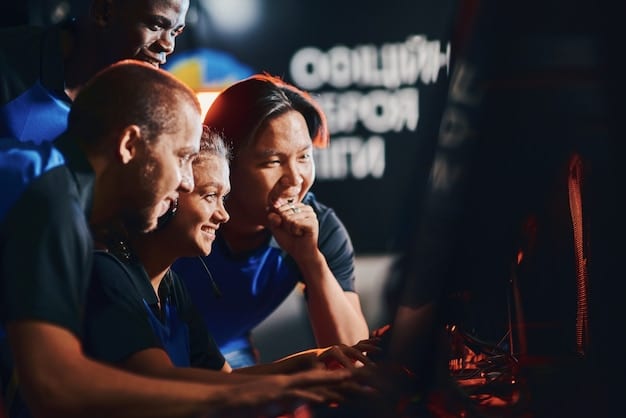Building a Championship Esports Team in the US: A Guide

Unlocking success in the American esports landscape necessitates a meticulous approach, encompassing strategic player acquisition, robust infrastructure development, stringent financial management, and effective brand building, all while navigating the competitive ecosystem to secure a sustainable presence and achieve championship aspirations.
The esports arena is a rapidly expanding frontier, evolving from niche competitions into a global phenomenon. For aspiring entrepreneurs and gaming enthusiasts in the US, the dream of establishing a dominant force in this dynamic world is increasingly attainable. This comprehensive guide details How to Build a Successful Esports Team in the US: A Step-by-Step Guide, offering insights from foundational planning to cultivating a winning culture.
Laying the Foundation: Vision, Niche, and Business Plan
Building a successful esports team begins long before the first player is signed. It requires a clear vision, a defined niche, and a meticulous business plan. Without these foundational elements, even the most talented players and coaches may struggle to find direction and sustainable success. This initial phase is about strategic foresight and diligent preparation.
A critical first step is to define your team’s core vision. What are your long-term aspirations? Is it to dominate a specific game title, become a multi-game organization, or foster a community-focused brand? Your vision should be ambitious yet realistic, guiding every subsequent decision. Simultaneously, identifying your niche is paramount. The esports landscape is vast; attempting to conquer every game or demographic from day one is often an unsustainable strategy. Focusing on a specific game, genre, or even a particular demographic allows for a targeted approach, enabling you to allocate resources more efficiently and build expertise within that chosen area. For instance, specializing in a popular First-Person Shooter (FPS) like Valorant or a Multiplayer Online Battle Arena (MOBA) such as League of Legends provides a clear pathway.
Crafting Your Business Blueprint
Once the vision and niche are established, the next crucial step is developing a robust business plan. This comprehensive document serves as your roadmap, detailing every aspect of your operation, from financial projections to marketing strategies. A well-constructed business plan is not just for securing funding; it’s a living document that will evolve with your team.
- Executive Summary: A concise overview of your team, vision, and objectives.
- Market Analysis: Research into the US esports market, including target demographics, competitors, and trends.
- Organizational Structure: Detail the roles and responsibilities of key personnel, including management, coaching staff, and players.
- Service/Product Offerings: Beyond competition, consider merchandising, content creation, and community engagement.
- Marketing & Sales Strategy: How will you build your brand, attract fans, and secure sponsorships?
- Financial Projections: Realistic budgets, revenue forecasts, and funding requirements.
Ultimately, laying this comprehensive foundation provides the stability required for growth. It differentiates a serious venture from a casual pursuit, setting the stage for sustainable development and competitive excellence in the challenging, yet rewarding, world of esports.
Assembling Your Talent: Recruitment, Scouting, and Development
The heart of any successful esports team beats with the talent it houses. Identifying, recruiting, and developing exceptional players and staff is a complex, continuous process that goes beyond merely spotting high-ranked individuals. It involves understanding the intricate dynamics of team play, individual skill, mental fortitude, and adaptability. This phase demands keen insight and a structured approach to talent acquisition.
Recruitment in esports isn’t just about raw mechanical skill. While crucial, a player’s ability to communicate effectively, maintain composure under pressure, and integrate seamlessly into a team environment often distinguishes a good player from a great one. Scouting involves delving into ranked ladders, competitive circuits, and even online communities to identify emerging talents. Look for players who not only demonstrate exceptional in-game performance but also possess a strong work ethic, a positive attitude, and a willingness to learn. Personality clashes can quickly derail a promising roster, making character assessment as vital as skill assessment.
Building a Cohesive Roster
Beyond individual players, the synergy within a team is paramount. A collection of highly skilled individuals does not automatically equate to a successful team. Coaching staff, analysts, and even sports psychologists play critical roles in fostering this cohesion. The coaching staff is responsible for strategy, individual improvement, and maintaining team morale. Analysts provide data-driven insights into opponent strategies and individual player performance, while mental health professionals can help players navigate the intense pressures of professional competition.
- Defined Roles: Clearly assign roles within the team (e.g., In-Game Leader, Support, Entry Fragger) based on player strengths and game meta.
- Trial Periods: Implement structured trial periods to assess player skill, compatibility, and attitude in a real-world team setting.
- Contract Negotiation: Secure players and staff with fair contracts that protect both parties, outlining compensation, performance incentives, and expectations.
- Talent Pipeline: Consider establishing an academy or junior team to nurture promising young players for future main roster transitions.
Player development is an ongoing commitment. It encompasses not only in-game skill refinement but also physical and mental well-being. Regular practice schedules, VOD (Video on Demand) reviews, personalized coaching, and a focus on healthy living contribute to sustained performance. Recognizing that player careers can be short, investing in their long-term growth and transition plans can also foster loyalty and a positive team image, making your organization an attractive destination for top talent.
Infrastructure and Operations: The Unseen Backbone
While talented players grab the headlines, the unseen infrastructure and smooth operations are the true backbone of a successful esports team. This involves creating a supportive environment that enables players to perform at their peak, managing logistical complexities, and ensuring the organization runs efficiently. Without robust infrastructure, even the most promising teams can falter under the weight of administrative burdens or lack of resources.
Establishing a suitable training facility is often a high priority. This space should be optimized for competitive play, equipped with high-performance computers, reliable internet connectivity, and comfortable ergonomic setups. Beyond the gaming equipment, consider areas for physical conditioning, team meetings, and relaxation. A well-designed facility can foster a professional environment conducive to focus and team bonding, minimizing distractions and maximizing productivity. For remote teams, establishing standardized communication channels and reliable online infrastructure becomes even more critical.
Managing Daily Operations
The day-to-day operations of an esports team are akin to running a small business, requiring meticulous planning and execution. This includes managing schedules, travel logistics for competitions, and ensuring all players and staff have the necessary resources and support. A dedicated operations manager often plays a crucial role in coordinating these elements, allowing players and coaches to focus on competitive performance.

- Practice Schedules: Develop structured practice routines that balance in-game training, VOD review, and breaks to prevent burnout.
- IT Support: Ensure reliable technical support for hardware, software, and network issues, minimizing downtime during critical practice and competition periods.
- Travel & Logistics: Efficiently manage travel arrangements, accommodation, and meal plans for tournaments, both domestic and potentially international.
- Compliance: Adhere to league rules, regulations, and reporting requirements, maintaining good standing within the esports ecosystem.
Ultimately, a strong operational framework translates directly into competitive advantage. When players feel supported, have access to top-tier equipment, and are freed from logistical concerns, they can dedicate their full energy to mastering their craft and achieving competitive success. This level of professionalism attracts not only top talent but also potential sponsors and partners.
Financial Sustainability: Budgeting, Sponsorships, and Revenue Streams
Esports, while exciting, is a business, and like any business, financial sustainability is paramount for long-term survival and growth. Securing adequate funding, managing budgets effectively, and diversifying revenue streams are critical challenges that every aspiring esports organization must address. This phase transitions from passion to pragmatic fiscal management.
The initial investment for an esports team can be substantial, covering player salaries, coaching staff, facilities, equipment, and travel. Developing a detailed, realistic budget that accounts for both initial setup costs and ongoing operational expenses is non-negotiable. This budget should project expenses for at least 1-2 years, providing a clear picture of financial needs. Potential funding sources include angel investors, venture capitalists specializing in sports or technology, and even crowdfunding. A compelling business plan with clear return-on-investment potential is essential for attracting these investments.
Diversifying Revenue Streams
Beyond initial investments and prize money (which can be sporadic and unpredictable), securing diverse and stable revenue streams is fundamental. Sponsorships typically form the largest component of an esports team’s income. Identifying brands that align with your team’s values and target audience is crucial. This involves extensive outreach, crafting compelling sponsorship proposals, and delivering tangible value to partners through brand activations, content creation, and fan engagement.
- Brand Partnerships: Collaborate with non-endemic brands (e.g., automotive, food & beverage) as well as endemic brands (e.g., gaming peripherals, hardware).
- Merchandising: Develop and sell team merchandise (jerseys, apparel, accessories) to capitalize on fan loyalty and create additional branding opportunities.
- Content Creation: Monetize content through platforms like Twitch, YouTube, and TikTok via advertising, subscriptions, and viewer donations.
- Tournament Winnings: While unpredictable, prize money from competitive success can provide significant boosts and validate the team’s competitive strategy.
- Fan Engagement Initiatives: Explore paid fan experiences, exclusive content, or membership programs for dedicated supporters.
Managing finances meticulously, continuously seeking new funding opportunities, and fostering strong relationships with sponsors and fans are critical for building a financially resilient esports organization. This not only allows for competitive investment in players and infrastructure but also ensures the team’s longevity in a rapidly evolving market.
Brand Building and Community Engagement: Cultivating a Following
In the modern esports landscape, a team’s success extends far beyond mere competitive victories. Cultivating a strong brand identity and fostering a passionate community are just as crucial, enabling sustainable growth, attracting sponsorships, and ensuring long-term fan loyalty. This phase focuses on connecting with the audience and establishing a distinct presence.
Your team’s brand is its public persona—its values, its aesthetic, and its voice. Developing a compelling brand story that resonates with your target audience is essential. This includes a memorable logo, consistent visual identity across all platforms, and a clear articulation of your team’s mission and ethos. Is your team known for its underdog spirit, its innovative strategies, or its engaging player personalities? Defining this identity helps in attracting and retaining fans who feel a genuine connection to your organization.
Engaging Your Community
Community engagement is about actively interacting with your fanbase, making them feel like part of the team. Social media platforms (Twitter, Instagram, TikTok, Discord) are indispensable tools for this. Regular updates about team performance, behind-the-scenes content, and player interactions humanize the brand and build rapport. Content creation, whether through live streaming, YouTube videos, or podcasts, allows fans to connect with players on a deeper level and follow their journeys.

- Consistent Content: Regularly publish engaging content across various platforms to keep your audience interested and informed.
- Player Personalities: Encourage players to develop their personal brands and interact with fans, as their individual followings often translate into team support.
- Fan Contests & Giveaways: Organize competitions or giveaways to reward loyal fans and attract new ones.
- Community Platforms: Establish a Discord server or other dedicated forum where fans can interact with each other and occasionally with players or staff.
- Merchandise & Events: Leverage merchandise and fan events (online or in-person) to strengthen community bonds and create memorable experiences.
Ultimately, a strong brand and an engaged community create a virtuous cycle. A larger, more passionate fanbase makes your team more attractive to sponsors, which in turn provides resources to invest further in competitive infrastructure and even more compelling content. This holistic approach ensures not just competitive success, but also a thriving, sustainable organization.
Legal & Regulatory Compliance: Navigating the Esports Landscape
Operating an esports team in the US is not solely about competitive prowess and financial acumen; it also requires diligent navigation of a complex legal and regulatory landscape. From player contracts to intellectual property and anti-doping policies, understanding and adhering to legal frameworks are essential for minimizing risks and ensuring the long-term integrity of your organization. This phase emphasizes the importance of professional and ethical conduct.
Player contracts are perhaps the most fundamental legal document for an esports team. These contracts should clearly outline terms of employment, compensation (salary, prize money split, streaming revenue), intellectual property rights (e.g., ownership of player likeness, content creation), ethical conduct, and termination clauses. It’s crucial to consult with legal professionals experienced in sports or entertainment law to draft contracts that protect both the organization and its players, preventing future disputes. Adherence to US labor laws regarding employment, taxation, and employee benefits is equally vital.
Ensuring Ethical Play and Fair Practices
Beyond contracts, esports organizations must operate within a broader regulatory framework. Adherence to league-specific rules and regulations is non-negotiable. This includes compliance with competitive integrity policies (e.g., anti-cheat measures, fair play rules), anti-doping policies (often mirroring traditional sports), and rules regarding player transfers and roster changes. Membership in professional esports associations or organizations can provide valuable guidance on best practices and industry standards.
- Intellectual Property: Secure trademarks for your team’s name, logo, and brand elements to protect your unique identity.
- Privacy Policies: Develop and adhere to privacy policies regarding player and fan data, especially when collecting information online.
- Sponsor Agreements: Ensure sponsorship contracts are legally sound, clearly defining deliverables, exclusivity clauses, and payment terms.
- Age Requirements: Be aware of and comply with age restrictions for competition in various leagues and games, especially if recruiting younger talent.
- Dispute Resolution: Establish clear internal processes for resolving disputes between players, staff, or management, potentially including mediation or arbitration clauses in contracts.
In an industry still defining its official structures, proactive legal compliance demonstrates professionalism and builds trust. It protects your investment, safeguards your reputation, and ensures your team can compete and grow without unnecessary legal impediments, contributing to a stable and reputable presence in the American esports scene.
Measuring Success and Adapting for Longevity
Building a successful esports team isn’t a one-time achievement; it’s an ongoing process of performance measurement, strategic adaptation, and continuous improvement. The esports landscape is dynamic, with new games, evolving metas, and shifting fan preferences. Therefore, the ability to measure success across multiple dimensions and adapt swiftly is crucial for longevity and sustained competitive advantage.
Competitive success is, of course, a primary metric. This includes tournament wins, consistent high placements in leagues, and improved individual player performance. However, success extends beyond trophies. Financial health, measured by consistent revenue growth, effective budget utilization, and profitability, is equally vital. Are sponsorships increasing? Is merchandise selling well? Are content monetization efforts yielding results? These financial indicators provide a clear picture of the team’s business viability.
Adapting to the Evolving Landscape
Fan engagement and brand growth are another critical dimension. Metrics like social media followers, content views, website traffic, and community interactions indicate the strength of your brand and the loyalty of your fanbase. A growing, engaged community translates into more opportunities for monetization and partnership. Employee and player satisfaction are also valuable metrics, as a happy and motivated team is more likely to perform at its best and remain with the organization.
- Regular Performance Reviews: Conduct consistent reviews for players and staff, focusing on both in-game and out-of-game contributions.
- Market Research: Continuously monitor esports trends, emerging games, and shifts in audience behavior to identify new opportunities.
- Feedback Loops: Implement systematic feedback mechanisms from players, staff, and even fans to identify areas for improvement.
- Technological Upgrades: Stay abreast of hardware and software advancements to ensure your team remains equipped with cutting-edge technology.
- Strategic Partnerships: Explore new collaborations with brands, tech companies, or other esports organizations to expand reach and capabilities.
Ultimately, longevity in esports hinges on a commitment to continuous learning and proactive adaptation. By meticulously measuring success across competitive, financial, and brand-building dimensions, and by fostering a culture of agility and innovation, an esports team can not only achieve short-term victories but also build a lasting legacy in the ever-evolving world of professional gaming.
| Key Aspect | Brief Description |
|---|---|
| 📊 Strategic Vision | Define game niche, clear goals, and a solid business plan for sustainable growth. |
| 🛠️ Infrastructure | Invest in high-performance facilities, reliable tech, and professional support staff. |
| 💰 Financial Stability | Secure diverse revenue streams through sponsorships, merchandise, and content creation. |
| 🤝 Community & Brand | Cultivate a strong brand identity and engage fans through consistent content and interaction. |
Frequently Asked Questions
Initial costs for an esports team in the US typically include player salaries and signing bonuses, coaching and support staff wages, high-performance gaming equipment, a dedicated training facility (or rent for offices), travel expenses for competitions, and marketing efforts. Legal fees for contracts and business registration also contribute significantly to the initial budget.
Player mental health is extremely important in competitive esports. The high-pressure environment, intense schedules, public scrutiny, and potential for burnout can significantly impact performance and well-being. Teams increasingly recognize the need for mental health support, often providing access to sports psychologists or counselors to help players manage stress, maintain focus, and develop resilience.
While major sponsorships often favor established organizations with large fanbases, new teams can certainly secure them. The key is demonstrating a clear value proposition, such as a unique brand story, a targeted audience appeal, impressive early competitive results, or a strong content creation strategy. A well-crafted pitch that aligns with a sponsor’s marketing objectives is crucial for new teams.
Content creation plays a vital role in an esports team’s success by building brand awareness, fostering community engagement, and creating additional revenue streams. Through platforms like Twitch, YouTube, and social media, teams can showcase player personalities, provide behind-the-scenes glimpses, and engage directly with fans, which in turn attracts sponsors and grows the fanbase beyond competitive results.
Common legal considerations for a US esports team include drafting robust player and staff contracts, ensuring compliance with labor laws (e.g., minimum wage, worker classification), protecting intellectual property through trademarks and copyrights, negotiating sound sponsorship agreements, and adhering to league-specific rules and regulations, including anti-doping and competitive integrity policies. Consulting legal counsel is highly recommended.
Conclusion
Building a successful esports team in the US is a multifaceted undertaking, requiring far more than just a passion for gaming. It demands strategic foresight, meticulous planning, a commitment to talent development, and robust business operations. From laying a solid financial foundation and fostering strong community ties to navigating the intricate legal landscape, every aspect contributes to a team’s potential for competitive excellence and long-term viability. As the esports industry continues its meteoric rise, organizations that prioritize professionalism, adaptability, and an unwavering focus on their vision are best positioned to achieve championship dreams and sustainable success.





